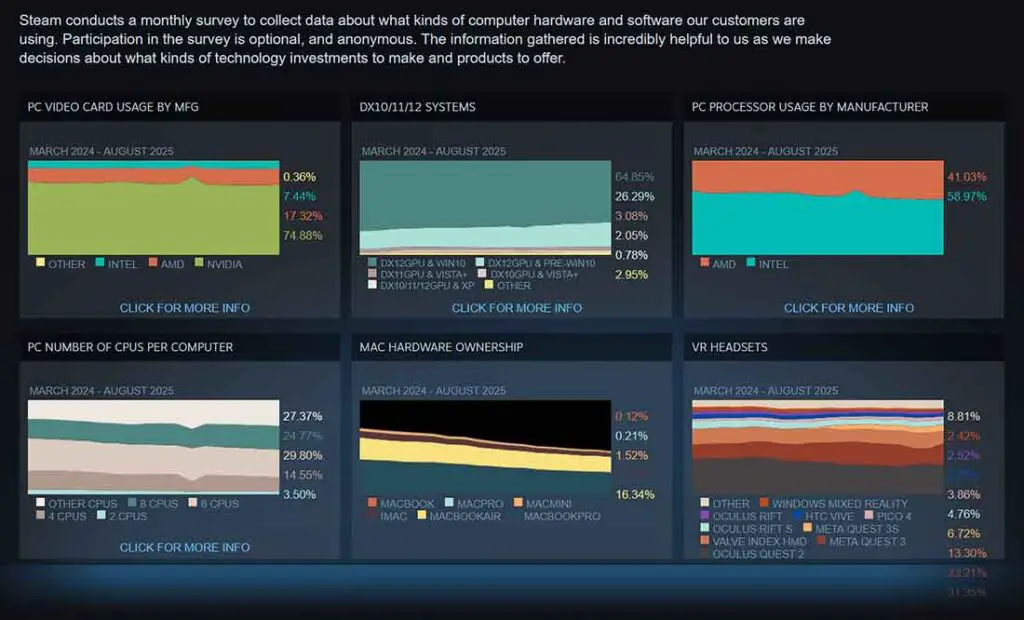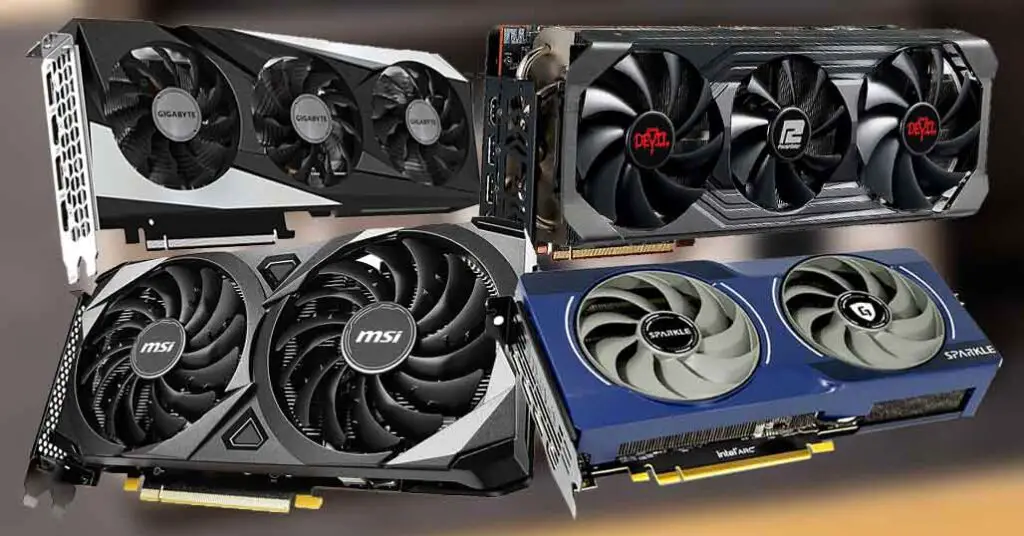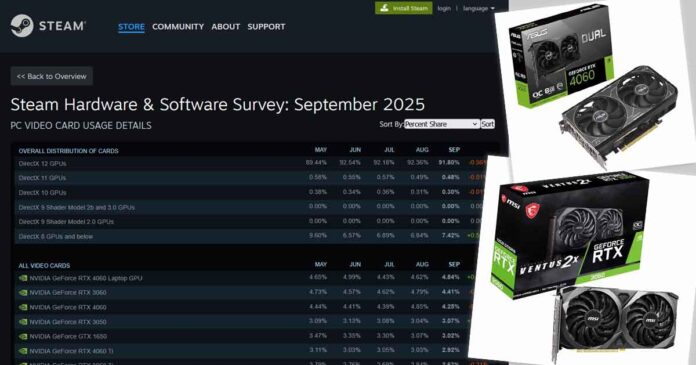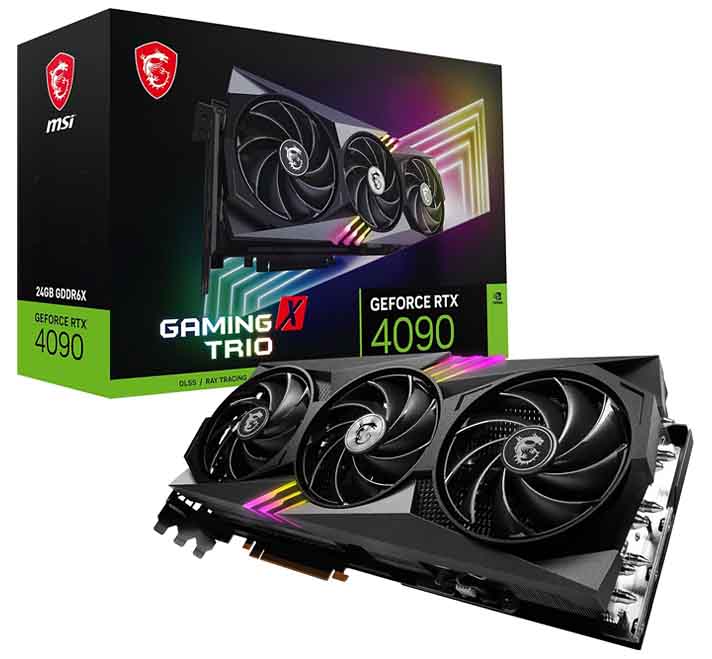If you’ve ever asked yourself what the most popular graphics cards used by gamers worldwide are, and you want the answer to be backed by pure statistics, the Steam hardware survey has all the data you’re looking for. Here are the top GPUs according to the Steam userbase, with a short commentary on each one of them based on the latest trends on the market.
Interested in the list of the absolute best GPUs you can get instead? You can find it here: Best GPUs To Upgrade To This Year – My Honest Take
This web portal is reader-supported, and is a part of the AliExpress Partner Program, Amazon Services LLC Associates Program and the eBay Partner Network. When you buy using links on our site, we may earn an affiliate commission!
What Can This Data Tell You?

As the list below is based entirely on the data from the Steam Hardware Survey regarding the graphics cards used by Steam users it can give us a pretty good insight into which graphics cards are actually used by real-life customers/gamers, not simply promoted by sellers trying to get you into buying the latest hardware at all cost.
It’s important to note that while this list is representative of the worldwide Steam user base, it’s not a list containing the best GPUs out there. Instead, the general sentiment of the Steam Hardware Survey always leans towards hardware that is (or at one point was) either:
- Affordable enough to be widespread among the users of one of the world’s most popular game distribution platforms.
- Popular enough to be considered by the general majority of gamers using Steam (the lack of popularity of the AMD and Intel GPUs in recent years might explain them appearing only at the very bottom of the original list over on Steam and thus not making it into our “top 10”).
- At some point highly available, either once it was brand new or when the aftermarket units came about.
- Efficient enough not to be upgraded after new potential upgrades have entered the market.
Of course there are many other factors that come into play when it comes to this data. One of them is without a doubt the pricing of the two most recent generations of NVIDIA GPUs which in many cases can rightfully make most money-conscious users reluctant to upgrade. Still, it’s one of the more interesting resources when it comes to the general knowledge of which cards are still effectively acting as the basis of the current gaming market this year.
Let’s get into the list of GPUs that are, according to the data from Steam, the graphics cards most commonly used by gamers as of now.
10 Most Popular GPUs Used by the Majority of Steam Users Worldwide
Here are the top 10 graphics cards from the Steam Hardware Survey list. This list doesn’t include integrated graphics cards (APUs), as well as laptop equivalents of desktop GPUs, and is solely based on the order in which the hardware is presented in the official ranking.
1. NVIDIA RTX 3060 12GB
- 12GB of VRAM is pretty good for its price point.
- Strong performance for 1080p and light 1440p gaming.
- Slower raw performance than the RTX 4060.
According to the latest results of the Steam Hardware Survey the NVIDIA RTX 3060 12GB is the most popular card among the Steam users in the month of September 2025. When it comes to true budget GPUs from NVIDIA’s lineup, the RTX 3060 is one of the most popular choices both among consumers who need a card for light 1080p and 1440p gaming and among people searching for a good budget-friendly GPU for local AI, including dual GPU setups.
With 12GB of GDDR6 VRAM and a price that’s just about $300 for a new card, the 3060 is one of the best options for affordable gaming setups, with the 3060 Ti offering a small upgrade in performance in comparison to the base version.
2. NVIDIA RTX 4060 8GB
- Great 1080p performance and power efficiency.
- Access to the latest NVIDIA technologies like DLSS Frame Generation.
- Only 8GB of VRAM, a limiting factor for future games and AI workflows.
The NVIDIA RTX 4060 8GB comes next. It’s not a mystery that with 8GB of VRAM the RTX 4060 isn’t the best card for most AI and LLM based applications and all adjacent memory intensive workflows. Still, it’s one of a few cards from the 4th generation on this list that’s worth considering. This one is quite interesting, as its laptop equivalent actually takes the first place on the list this month.
With its rather good benchmark performance placing it right next to a brand new Intel Arc B580, it’s a card that’s still pretty much a solid contender when it comes to the more budget-friendly choices. If you want an even more worthwhile alternative, you might want to take a look at the RTX 4060 Ti, which offers a much more future-proof 16GB of VRAM for just a little bit higher price.
3. NVIDIA RTX 3050 6GB
While the NVIDIA RTX 3050 is much cheaper than the 3060, it also has only 6GB of video memory, which in the current year is way below the standard for desktop PCs, and would be something you would rather see on a mid-range gaming laptop.
If you need a GPU under the $200 mark, you might consider the 3050, either new or used. Still, there are much better options for just a little bit more, including the aforementioned RTX 3060 12GB, and the Intel Arc B580.
You might also like: Intel Arc B580 & A770 For Local AI Software – A Closer Look
4. NVIDIA RTX 1650 4GB
- Extremely low power consumption (around 75W under load).
- Lacks modern features like DLSS and ray tracing
- Only 4GB of VRAM on board.
- Vastly outperformed by essentially all modern budget cards.
On the third place, we can find the NVIDIA RTX 1650 4GB, which is a much older GPU than the first two we just went through. Unlike any of the other cards on this list, it’s not really worth considering, knowing that you have much better, more efficient and just as cheap alternatives such as the RTX 3060, or the RTX 3050 mentioned before.
5. NVIDIA RTX 4060 Ti 8GB / 16GB
The NVIDIA RTX 4060 Ti is essentially an upgraded version of the base RTX 4060, which, as you already know, is currently the most popular GPU among Steam gamers. It gets approximately 16% better average benchmark scores than the 4060, and what’s more important, comes in options with much more video memory (you can find both 8 and 16GB VRAM models).
If your budget allows it, a new or second-hand RTX 4060 Ti with 16GB of VRAM on board is a pretty good choice. On this list, the only card that can rival either the base 4060 or its Ti version is the RTX 4070, which we’re going to talk about in just a bit.
6. NVIDIA RTX 3060 Ti 8GB
- Better gaming performance than the standard 3060.
- A great value on the used market for 1080p/1440p gaming.
- Only 8GB of VRAM, less than the cheaper base 3060.
Faster base clock speed, more CUDA and tensor cores, and a wider memory bus make the NVIDIA RTX 3060 Ti 8GB a much more powerful card than the base 3060. However, it comes with a trade-off, which is less VRAM. With only 8GB of video memory, the RTX 3060 Ti is faster in raw performance for today’s games but may struggle sooner than the 12GB 3060 both in more demanding games, and memory heavy workflows.
As the card is both older and sits in a confusing spot between the 3060 and 3070, it can still be a reasonably good pick on the second-hand market if you can find it for a good price, are primarily focused on 1080p gaming, and don’t mind the lower amount of VRAM on board.
7. NVIDIA RTX 3070 8GB
- Great performance for 1440p gaming.
- Good value when purchased second-hand.
- Once again, a card limited to 8GB of VRAM can be a bottleneck for many newer titles and VRAM-sensitive workflows.
The NVIDIA RTX 3070 8GB used to be named by many gaming outlets “the 1440p champion” on its release, offering performance similar to the previous generation’s flagship, the RTX 2080 Ti, at a much lower price. It’s still a very capable card for high-refresh-rate 1080p and solid 1440p gaming.
Like the 3060 Ti, its main weakness today is its 8GB of VRAM. While sufficient for most current games, it’s a limiting factor when it comes to looking out for the future, as well as for local AI workflows. If you’re buying today, and you’re on a tight budget, you can find quite a few good deals for a used 3070, but for a new purchase you might be better off considering an RTX 4060 Ti 16GB or an RTX 4070 instead.
8. NVIDIA RTX 4070 12GB
This is the most recent card on the list in terms of its market release date. The base NVIDIA RTX 4070 has 12GB of VRAM, is and was a popular choice for 1080p as well as 1440p gaming, and overall is a GPU that still holds up really well, and is definitely worth looking at if you can find it for a good price.
Coming with a lot of new variants such as the RTX 4070 Super, Ti, and Ti Super, the base 4070 model is a great mid to high range GPU choice for most applications, and it’s not a surprise that it’s still one of the most popular GPUs used by the Steam users.
9. NVIDIA RTX 2060 6GB
- Still capable of 1080p gaming in many popular titles.
- Its 6GB of VRAM is insufficient for most modern games and may be too little for many modern applications.
- Lacks the efficiency of newer budget cards.
The NVIDIA RTX 2060 6GB is the predecessor of the 2060 Super, as well as the 2070 and the RTX 2070 Super, and it’s one of the older GPUs that because of their lower amount of VRAM are mostly considered obsolete for any serious gaming these days.
If you’re not afraid of picking up a much older card with less than 8GB of VRAM, the 2nd generation NVIDIA GPUs can still be pretty efficient at some lighter gaming and simple workflows. Still, these are largely outclassed by newer budget options, and the RTX 2060’s continued popularity is a testament to its excellent value back when it launched.
10. NVIDIA GTX 1060 6GB
The NVIDIA GTX 1060 takes the last place on our list, and to be completely honest, much like the GTX 1650 it’s a card that doesn’t offer any real value these days. While it’s perfectly serviceable in an already existing older setup, there really is no reason to purchase one today.
Taking into account that the 1060 will soon be as old as 10 years and that both its benchmark scores and VRAM capacity are much below today’s standards, the only real takeaway here is that while it’s still going strong, it isn’t really a viable option, even for budget gaming builds.
So, Should You Pick Any of These?

It really depends on your budget and needs. This list proves one thing: you don’t need the latest and greatest to be a PC gamer, and not only that, to be in the strong majority of high-to-mid-range gaming setup users. Cards like the RTX 3060 12GB and RTX 4060 Ti 16GB still stand out as solid budget choices from this list for anyone building or upgrading your GPU today. The RTX 4070 is also an excellent higher-end option if your budget allows.
The older cards, like the GTX 1060, GTX 1650, and RTX 2060, are still popular because they’re already installed in millions of systems worldwide. However, for quite understandable reasons, hardware that is now over half a decade old, is not really recommended for new purchases. These cards represent the baseline that game developers often target, but for a good experience in modern titles, most of the time you’ll want something more powerful.
Looking for an affordable GPU? – You might want to check this out: Top 7 Best Budget GPUs for AI & LLM Workflows This Year
The Steam Hardware Survey offers us a great look at what people are actually using, not what’s being marketed and pushed towards the general collective as the new generations of GPUs come out with their ever-growing market prices. It mostly shows us a landscape dominated by budget-conscious decisions and GPUs that offer great value for their time and hold up reasonably well to this day.
A word on AMD? Well, the very first AMD card on the list, the Radeon RX 6600, only has a 0.89% share, which means that the majority of gamers are still reluctant to try AMD hardware when it comes to GPUs. Still, it’s a reminder that good alternatives exist, even if they don’t capture the same market share these days.











